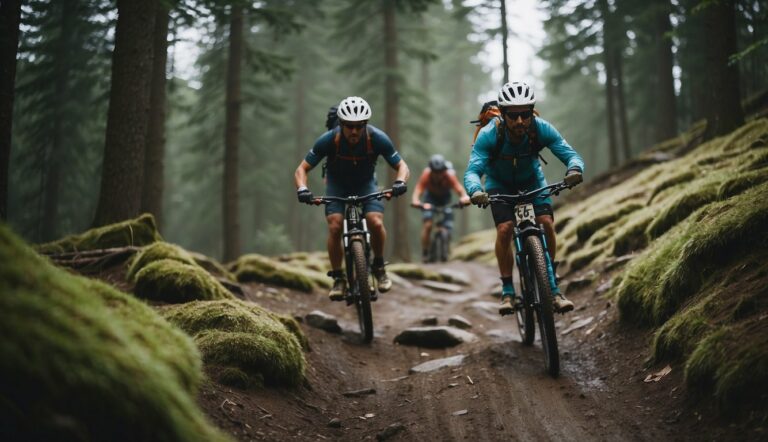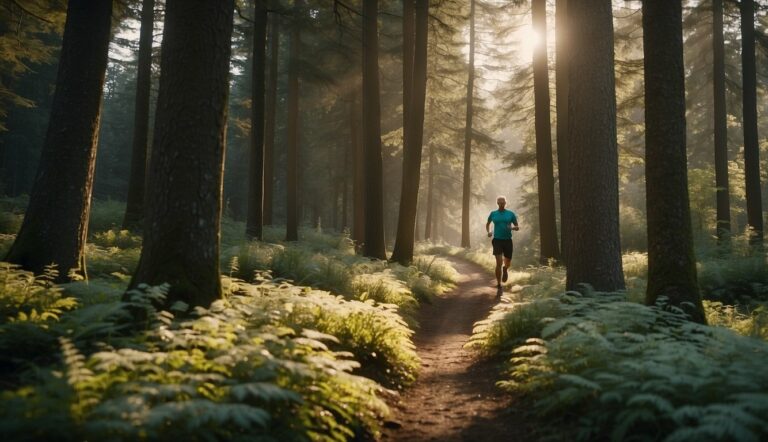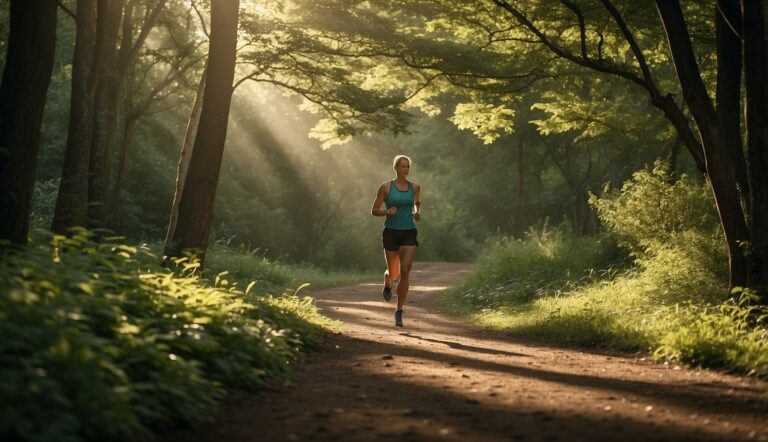How Should Trail Running Shoes Fit? Ensuring Comfort & Performance on the Trails
Selecting the right trail running shoes is crucial for comfort and performance on uneven terrain. I always advise runners to find a shoe that provides a snug, supportive fit while still allowing for natural foot movement. This means the shoes should be tight enough to prevent excessive movement, which can lead to blisters, but not so tight that they cause discomfort. Consider the shape of your foot and whether you need a wide toe box to accommodate foot expansion, especially during longer runs.
It’s also essential to consider the demands of the trails you’ll be running on. The outsoles should have ample traction to handle dirt, mud, and rocks, and the uppers need to be durable to withstand the natural wear and tear from the elements. Things like a rock plate for underfoot protection or reinforced materials can make a significant difference in comfort and durability.
My approach is to always prioritize fit over brand or appearance when coaching runners on footwear selection. Remember that everyone’s feet and running style are unique, so what works for one runner may not work for another. Take the time to assess your needs and make sure the trail running shoes you choose meet those needs adequately.
The Perfect Fit for Trail Running Shoes: Sizing and Comfort

As a UESCA certified running coach, I understand the importance of proper shoe fit for trail running. It’s crucial to balance snugness and roominess for maximum comfort and performance.
Understanding Sizing and Measuring
To determine your ideal shoe size, measure your feet’s length and width at the end of the day when they’re largest. Use a sizing chart to find the corresponding shoe size. Remember that sizing may vary between brands.
- Foot Measurement
- Length: Measure from the heel to the tip of the longest toe.
- Width: Measure the broadest part of your foot.
Width Considerations and Foot Shape
Your shoe width is just as important as length. Shoes should accommodate natural foot spread without pinching or causing blisters. Wide feet may require wide-width models, while narrow feet may need shoes with less volume.
- Shoe Width Options
- Standard: best for medium width feet
- Wide: best for wide feet
- Narrow: best for narrow feet
Heel Fit and Midfoot Security
The heel should fit snugly without slipping, and the midfoot should feel secure but not overly tight. A proper heel fit prevents blisters, while a firm midfoot ensures stability across uneven terrains.
- Snug Heel and Midfoot Checklist
- Heel: No vertical slippage
- Midfoot: Comfortably secure without pressure
Toe Box Space and Forefoot Comfort
The toe box should allow your toes to wiggle freely. Aim for a thumb’s width of space ahead of the longest toe to account for swelling and natural foot movement while running.
- Forefoot Comfort Guide
- Toe Box: Sufficient room for toe wiggle
- Space: A thumb’s width from the longest toe to the shoe front
Lacing Systems and Adjustability
Proper lacing systems and adjustability in trail running shoes are crucial for creating a secure fit. This ensures correct arch support and prevents unwanted movement that could lead to blisters or injuries.
Customizing Fit Through Lacing
I find that the lacing system of a trail running shoe is key to a customizable fit. A secure lacing system should allow for tightness adjustments across different parts of the foot. For example, runners can adjust the laces at the midfoot to ensure a snug feel without constriction, providing both comfort and stability. Here’s how I recommend adjusting your laces:
- At the Midfoot: Tighten laces to ensure your foot feels locked in place, avoiding over-tightening that can restrict blood flow or cause numbness.
- At the Ankle: Lace up to the top eyelet for increased ankle support, which helps prevent rolling the ankle on uneven surfaces.
- Heel Hug: A proper heel hug is achieved when the shoe secures the heel in place without slippage.
The Role of Insoles and Arch Support
Insoles and arch support are integral for foot alignment and can enhance the fit of the shoe further. If a shoe’s built-in arch support doesn’t match your foot’s arch, consider an aftermarket insole for a better fit. Look for features like:
- Arch type compatibility: Match the insole’s arch support to your foot’s arch type (low, medium, or high).
- Material: A firm yet cushioned insole material can enhance comfort and durability.
Remember, the sensation should be supportive, not intrusive. Your foot’s natural mechanics should not be impeded by the shoe’s structure.
Preventing Common Trail Running Issues
In trail running, the right shoe fit can prevent a range of issues including blisters, injuries, and discomfort. Understanding how to choose and use footwear will enhance performance and enjoyment on the trails.
Overcoming Blisters and Hotspots
Blisters and hotspots are often the result of friction due to ill-fitting shoes or inappropriate socks. To prevent these issues:
- Socks: Opt for socks made of a wicking material like merino wool or synthetic fibers to keep feet dry and reduce friction.
- Fit: Ensure your trail shoes are snug but not tight, with enough room to wiggle toes. The heel should be secure without slipping.
For an effective fit to prevent blisters and hotspots:
| Shoe Part | Fit Criterion |
|---|---|
| Toe Box | Roomy to prevent toe rubbing |
| Midfoot | Snug to prevent in-shoe movement |
| Heel | Secure without slipping |
| Overall Width | No pinching or excessive pressure points |
Choosing Shoes for Weather Adaptation
Your choice in trail shoes should accommodate weather conditions to maintain comfort and performance.
- Waterproof Shoes:
For wet conditions, waterproof shoes with a Gore-Tex layer can help keep your feet dry in snow or mud. - Breathability:
Ensure shoes offer breathability for dry conditions to prevent overheating and excessive moisture. - Outsole:
A rugged outsole provides grip on slippery surfaces and stability on rocky terrain.
To adapt to different weather conditions:
| Weather Condition | Shoe Features |
|---|---|
| Wet and Snowy | Waterproof membranes like Gore-Tex, aggressive tread for traction |
| Hot and Dry | Breathable uppers, moisture-wicking liners |
| Muddy | Non-clinging lug pattern, waterproofing |
| Rocky | Stiff soles for protection, snug fit for precision |
By selecting the right shoes and wearing suitable socks, you can reduce common trail running issues such as blisters, discomfort, and injuries, while ensuring optimal trail performance regardless of weather conditions.
Advanced Trail Running Shoe Considerations
When selecting trail running shoes, advanced considerations such as transitioning to zero-drop designs and knowing when to replace your shoes are vital for both performance and safety.
Transitioning to Zero-Drop or Minimalist Designs
Zero-drop shoes, like those offered by Altra, including the popular Altra Lone Peak, feature a heel and toe on the same plane, promoting a natural foot position.
Research suggests these designs can increase foot strength and improve running form. Before switching, I recommend a gradual transition to allow your body to adapt, as the lower stack height increases calf and Achilles tendon demands.
| Transition Plan | Duration | Purpose |
|---|---|---|
| Standard Drop | 1 Month | Initial |
| Reduced Drop | 1 Month | Adapt |
| Zero-Drop | Indefinite | Fully Transitioned |
When to Replace Trail Running Shoes
Knowing when to replace trail running shoes is crucial, with experts often suggesting a range of 300-500 miles as the benchmark. Look for signs of wear, such as diminished traction or midsole compression.
Ultramarathoners or those regularly in rugged conditions might consider following the lower end of this mileage range and opt for shoes with aggressive traction or features like microspikes for additional grip.
| Mileage | Shoe Condition | Action Needed |
|---|---|---|
| < 300 | Good | Continue Use |
| 300-500 | Worn | Evaluate Replacement |
| > 500 | Compromised | Replace |
Determining Your Trail Running Shoe Needs
When preparing for trail running, choosing the right shoes is vital. I consider both the terrain and specific body mechanics to provide tailored advice for optimum comfort and stability.
Analyzing Terrain and Trail Conditions
Trail conditions significantly influence the choice of trail running shoes. For off-road terrain, the focus is on traction, support, and durability. Here’s how I match shoes to different terrains:
- Smooth Trails: Look for lightweight and moderate traction.
- Rocky, Technical Terrain: Opt for shoes with a sturdier build and aggressive tread for grip.
It’s essential to consider weather conditions as well because wet and muddy trails require shoes with more aggressive lugs to prevent slipping.
Assessing Running Style and Body Mechanics
Running style and body mechanics play a crucial role in shoe selection:
- If your stride is more forefoot or midfoot, you’ll want a lower heel-to-toe drop for a natural feel.
- For heel strikers, shoes with more cushion at the heel can help absorb impact.
Here’s a simple way to think about it:
| Running Style | Heel Drop | Cushioning |
|---|---|---|
| Forefoot/Midfoot | Low | Moderate |
| Heel Striker | Higher | Enhanced |
Remember, everyone’s body is different, so what works for one runner may not work for another. Checking in with a professional or a specialty running store can provide personalized advice.
Key Features of Trail Running Shoes
The key features of trail running shoes enhance performance and safety on uneven terrain. These shoes are specifically designed with reinforced grip, durable construction, and support features to tackle the rigors of off-road running.
Importance of Grip and Outsole Design
The outsole is the critical interface between your trail running shoes and the ground. Grip and traction are fundamental for preventing slips and falls on loose or rugged surfaces. A well-designed outsole will have lugs—protrusions that improve the shoe’s grip. For muddy and soft trails, look for deeper lugs, while shorter lugs work best for hard-packed dirt.
- Optimal Lug Depth for Various Terrains:
- Soft, muddy trails: 5-7mm
- Hard, dry trails: 2-4mm
Midsole Support and Cushioning
The midsole provides cushioning and shock absorption, essential for long-distance comfort and reducing impact stress on joints. Hence, a quality midsole balances cushioning and stability. A rock plate, inserted between the midsole and outsole, offers protection against sharp rocks and roots.
Upper Construction and Material Choices
The upper should be made of breathable materials to allow moisture and heat to escape, maintaining comfort over distance. In wet conditions, waterproof features like GORE-TEX linings keep feet dry. Yet, breathability should not be sacrificed completely for waterproofing, as shoes still need to manage internal moisture from sweat.
Additional Protection and Durability Aspects
Durability in trail running shoes comes from robust materials and thoughtful design. Reinforced areas protect against wear from trail debris. Added features may include toe caps for impact protection and heel counters for increased support. Durability does not mean excessive weight, though; the best trail shoes strike a balance between protection and agility.






